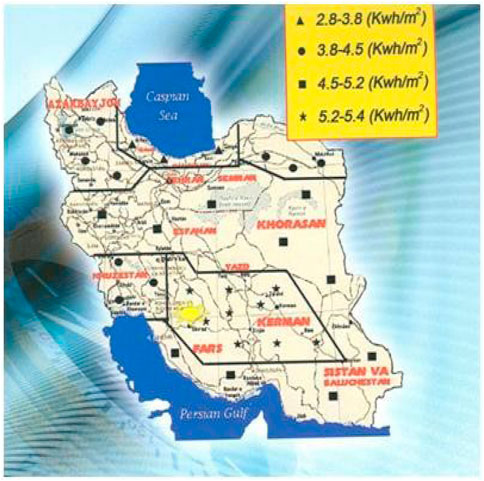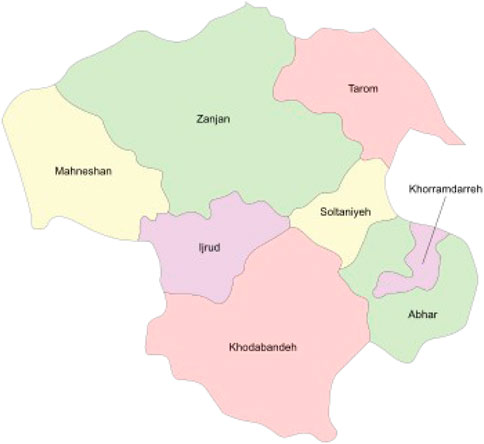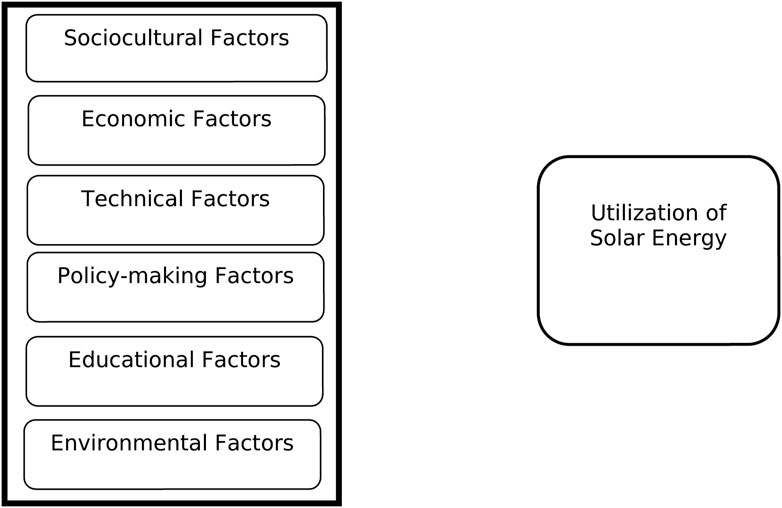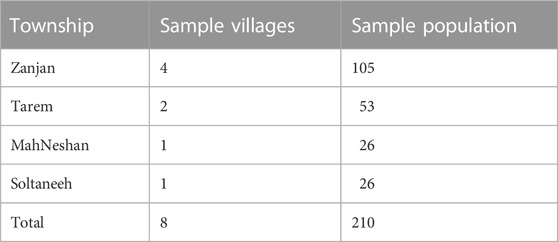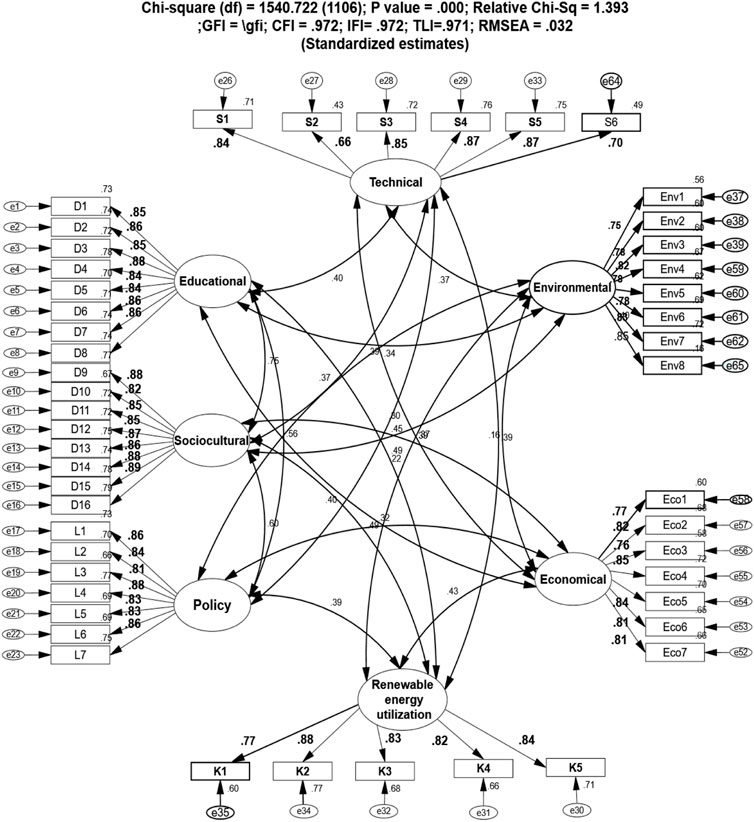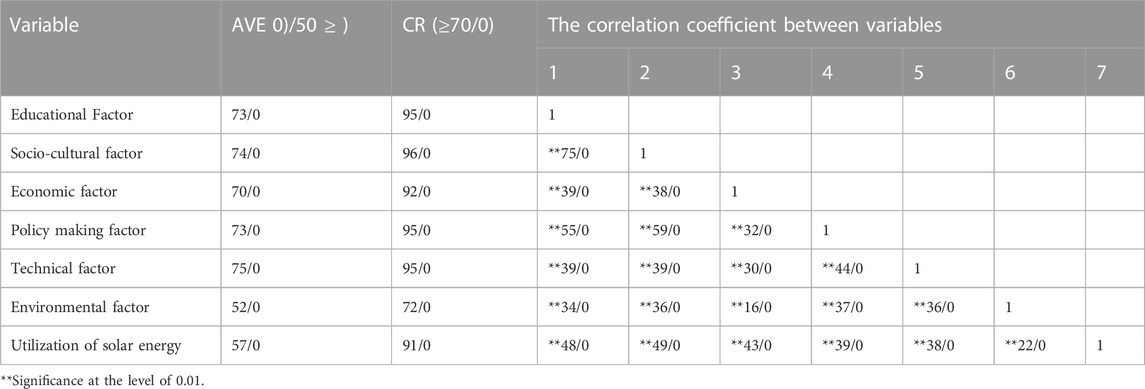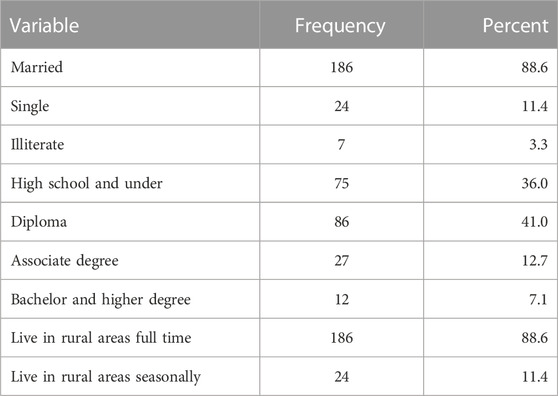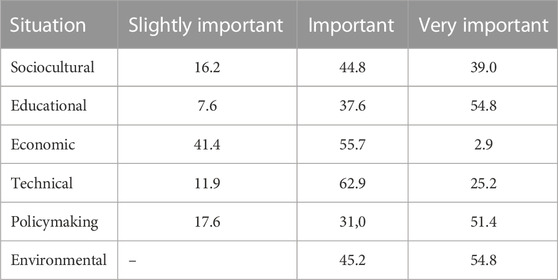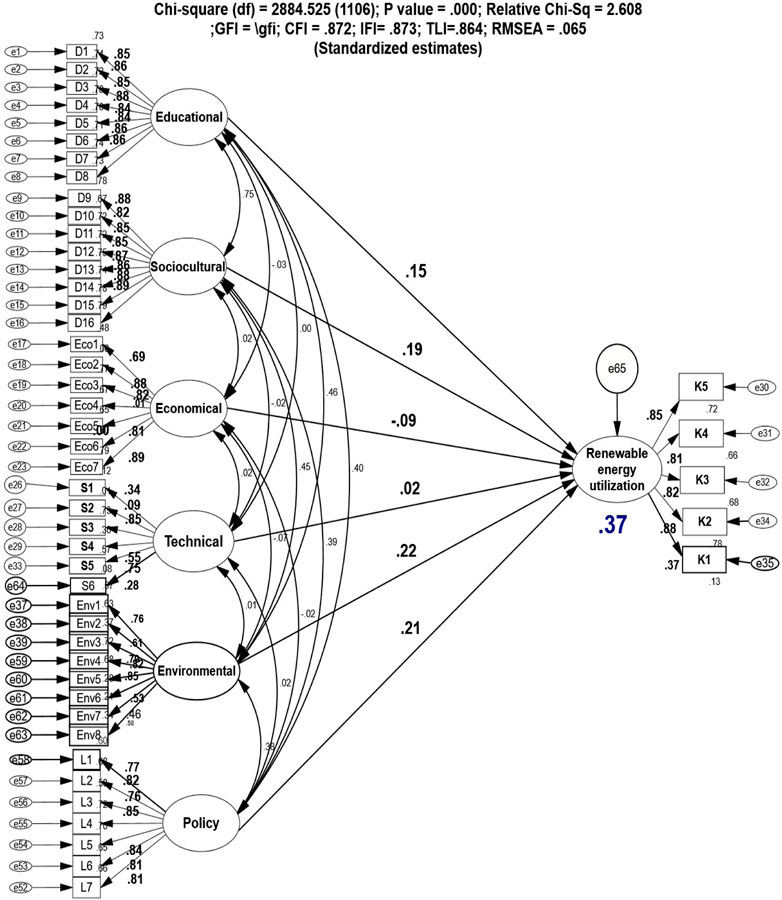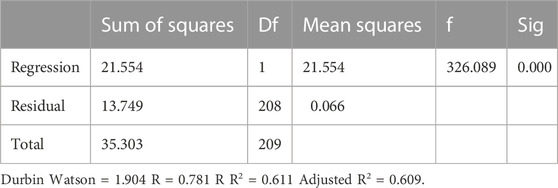- Department of Agricultural Economics, Extension and Education, Science and Research Branch, Islamic Azad University, Tehran, Iran
This study was conducted to investigate the role of factors affecting the utilization of solar energy for the sustainable rural development of Zanjan Province. The statistical population in this study was rural households who used solar energy technology in Zanjan Province, and 210 households were selected as a sample using Kerjesi & Morgan’s table. The data collection tool was a questionnaire. The face and content validity of the questionnaire was confirmed by a panel of experts before the pre-test. The reliability of the research tool was also confirmed by conducting a pre-test among thirty people other than the statistical sample and calculating Cronbach’s alpha for the main scales of the questionnaire (in the range of 0.72–0.90). Data were analyzed using SPSS24 and AMOS22. The data were analyzed using structural equation modeling. The results showed a positive and significant relationship between educational, socio-cultural, policymaking, and environmental factors and the utilization of solar energy, and these variables explained 37% of the variance of the dependent variable. However, a weak significant relationship was observed between economic and technical factors with the utilization of solar energy. The finding of this study has some meaningful policy implications. The energy costs, sunlight coverage, and the efficiency of solar energy systems have caused solar energy to be considered as a suitable alternative for providing electricity and heating in rural areas of Iran.
1 Introduction
The last century witnessed extensive development in the energy systems and factors such as reduction in fossil fuel reserves, environmental degradation, and regional imbalances have led to a change in global trends toward the utilization of clean energy (Karami Dehkordi et al., 2017; Shahsavari and Akbari, 2018). The development of renewable energy has turned out to be one of the key solutions to deal with climate change and undesired environmental conditions, and it has been accepted as a necessary policy by many countries in the world (IRENA, 2015; UNDP, 2015).
To achieve sustainable economic, social and environmental development in rural areas, it is necessary to improve the level of knowledge and awareness of the rural population about the optimal use of diverse environmental resources such as renewable energy (Amundsen and Martinsen, 2015). Renewable energy is considered the basis of sustainable energy supply systems (Hosseini and Soltani, 2011; UNIDO, 2018) and the development of this energy in rural areas will help to improve energy security, to enhance the relationship between human agricultural activities and forest protection, and to reduce environmental degradation including deforestation and desertification (Dai et al., 2016; Shahsavari and Akbari, 2018; Li et al., 2019).
The provision of clean, frequent, dependable, and financially available energy services along with providing security and preserving the environment are some of the most important indicators of sustainable development (Kargar Dehbidi et al., 2020).
Renewable energies have various common benefits such as improving environmental conditions due to the reduction of greenhouse gas emissions from power plants, reducing noise and heat pollution, diversifying the energy sector, reducing the effect of energy price fluctuations on the economy, and providing security in the national economy. Because fossil energies are vulnerable to political instability, trade disputes, sanctions, and other crisis, they are also effective in increasing economic productivity and national production rate (GDP) with more efficient production processes (FPLC, 2013).
Oates (2019) by citing Navarra, pointed out the importance of innovative solar projects which benefit low to moderate-income families and would offer them affordable, clean, and resilient energy.
In a study by Fatima et al. (2021), key outcomes which affect the generation of renewable energy are lack of good governance, renewable energy adaptation, and governmental energy policies are revealed to be the crucial barriers to REG development, whereas endowed resources, power production approach, renewable energy demand, investment environment for renewable energy projects, economic returns of renewable energy projects, environmental effects, and public acceptance are found to be the crucial drivers of REG development.
Since the signing of the Paris Agreement on Climate change by 196 countries, there has been a continuous interest in finding viable and sustainable renewable energy sources per the commitment of signatures of the above-mentioned agreement (Aboagye, et al., 2021).
Based on the Energy Progress Report, tracking SDG (World Bank, 2022) “the global share of renewable energy sources in total final energy consumption (TFEC), inclusive of traditional uses of biomass, was 17.7 percent, just 0.4 percentage points higher than the year before. Despite notable growth in renewable energy consumption over the decade between 2010 and 2019, the share of renewable sources in TFEC, excluding traditional uses of biomass, increased by just 2.7 percentage points and represented only 11.5 percent of TFEC in 2019. This modest pace of growth points to the importance of containing energy consumption through energy efficiency and energy conservation, ensuring access to affordable, dependable, sustainable, and modern energy for all implies an accelerated deployment of renewable energy sources in all three conventional categories: Electricity, heat, and transport.”
The market share of solar and wind in global electricity generation grew at a compound average annual growth rate of 15% from 2015 to 2020. If exponential growth continued at this rate, solar and wind would reach 45% of electricity generation by 2030 and 100% by 2033. In 2012, the International Energy Agency predicted that solar energy production would reach 550 TW h by 2030, but this amount increased in 2018. Early models assumed that the growth of solar and wind energy would be linear, but in reality, this growth has become exponential (Jaeger, 2021).
The report of Energy Progress (World Bank, 2022) about Sustainable Development Goals (SDG) for 2030 elaborated on the share of renewable energy in global energy. The report shows that the use of renewable energy for electricity grew more than 5 percent in 2019, bringing the share of renewables in global electricity consumption to 26.2 percent, up from 25.3 percent in 2018, the largest share of renewables among the end-use categories. Renewable heat consumption increased by 2.4 percent to 17.8 EJ in 2019, excluding traditional uses of biomass. The consumption of modern renewables for heat (that is, excluding traditional uses of biomass) increased by 2.4 percent year-on-year in 2019, while global heat demand saw a slight increase (+ 0.3 percent year-on-year).
Solar energy is a huge source of clean and sustainable electricity generation without toxic pollution or global warming emissions. The negative environmental effects of solar energy in terms of land use, water use, and the use of hazardous materials in the production of technologies related to this energy are less than fossil energy (Union of Concerned Scientists, 2013).
The three most crucial factors of the adoption of renewable energy technology by the rural population are, first, emphasizing the relative advantage of modern technologies, second, providing the economic requirements for adequate financing for the adopters, and third addressing the social dimensions related to the use of these technologies by adopters (Eder et al., 2015; Sezgin et al., 2011).
Eidi et al. (2021) in a study on the factors affecting the possibility of using solar energy in the agriculture sector from the point of view of agricultural experts explained the variables of informational, political, educational, technology-cost, attitudinal, psychological, and support requirements as the effective ways of using solar energy in the agriculture sector.
Zamani Farhani et al. (2015) in assessing the factors affecting the use of solar energy technology in the agriculture sector of Iran, found that there was a positive and significant correlation between economic, sociocultural, education, research, organizational, and policy-making factors with using solar energy technology in the agricultural sector. The results of multiple regression also showed that economic factor has a more important effect on the dependent variable of using solar energy technology in agriculture.
The results of a study in rural areas of China showed that relatives and families who adopted solar energy had a positive impact on the utilization of solar energy by farmers. Environmental and health factors also had a significant effect on the adoption of solar energy by farmers (Yanjiao, et al., 2023).
Zahari and Esa (2018) indicated that the perceived utility of innovative technology, the perceived utility of renewable energy, and the perceived benefit of modern technology were seen as the drivers of the adoption of renewable energy. At the same time, two inhibitor constructs, namely, perceived risk and perceived no need, were not seen to create a negative connection relating to the adoption of renewable energy. By contrast, as hypothesized, the perceived expense was the only factor that negatively correlated with intending to adopt renewable energy.
The technology used for the use of renewable energies should be under the conditions and needs and local capacities of renewable energies in terms of techniques, exploitation, and maintenance (Martin and Rice, 2012; Benedek et al., 2018). Safety, risk level, sustainability, and production potential in the future will affect the satisfaction and social acceptance of renewable energy sources (Tigabu et al., 2015; Dehhagi and Chobchian, 2017).
The social and cultural factor of using renewable energies is a social process in which people’s understanding of this energy plays a key role in accepting and using them (Bai et al., 2016; Gorbannezhad et al., 2018; Rezaei and Ghofranfarid, 2018). Evidence shows that the development of renewable energy has the potential to spread, and when solar panels are installed in a place, others are likely to show more willingness to use solar energy (Jaeger, 2021).
Educational factors show the role and importance of environmental and cultural development in economic development and the necessity of training to achieve these goals (Martin and Rice, 2012; Afsharzade et al., 2016; Koopmans et al., 2018). Different educational strategies are very necessary to increase the awareness of rural populations about these types of energy (Rezaei and Ghofranfarid, 2018; Gorbannezhad et al., 2018; Bojnec and Papler, 2011).
Sharma. (2021) examined the attitude of consumers toward solar water heaters in Arizona. The results show that consumers have a favorable perception of solar water heaters, and those with higher annual income and better educational qualifications are willing to adopt the new solar technologies.
The economic and educational factors had an impact on the adoption of solar in Uganda. It was reported these two factors provided the ground for the adoption of solar PV (Aarakit, et al., 2022).
Economic factors are among the other barriers to moving towards renewable energy sources and changing energy use patterns (Martin and Rice, 2012; Stigka et al., 2014; Afsharzade et al., 2016). Governments should support renewable energy projects in rural areas through appropriate policies, allocation of sufficient financial resources, and providing low-interest loans (Shahsavari and Akbari, 2018; Eidi et al., 2021).
Studies show that one of the main factors in the development of renewable energy was cost reduction. The cost of generating electricity from solar and wind energies has decreased by up to 85%, which has increased the competitive power of producing fuel from renewable sources with fossil fuels (Jaeger, 2021).
Laureti et al. (2018) in a study about the economic advantages of renewable energy in OECD countries concluded that renewable energy created indirect and induced effects on the OECD countries’ economies, and in particular contribute to the reduction of unemployment.
The policymaking factors play a key role in allocating funds, investing, and accelerating the use of renewable energy technologies (Martin and Rice, 2012; IRENA, 2015;1 Bai et al., 2016; Lange et al., 2018; Van Gevelt et al., 2018; Bishoge et al., 2020). Renewable energy policy tools can be divided into three categories: 1) financial incentives; 2) regulations and binding instruments and 3) accompanying measures (Jordan Korte, 2011).
Supporting policies are very necessary for the development of renewable energies, and measures such as tax exemptions and subsidies can help in reducing costs and utilizing these energies. Different countries have invested in research and development of this type of energy. China, Europe, and the United States have been pioneers in determining and adopting supportive policies. In addition, more than 165 countries have set the development of renewable energies as their priority in the energy sector (Jaeger, 2021).
The use of renewable energy is effective in reducing environmental degradation, including deforestation and desertification, and promoting sustainable agricultural techniques and environmental protection in rural areas (Dangerman and Schellnhuber, 2013; Dehhagi and Chobchian, 2017; Daneshvari et al., 2020).
The impact of solar energy on the reduction of carbon emissions can not be neglected. However, there is a need for investment and development of technological innovation in solar energy to accelerate and facilitate the process. The results of a study in China show that it will take about 8 years for solar energy investment to help the carbon emission reductions (Zhao et al., 2023).
The study of the use of renewable energy in Ukraine shows that rural areas have a significant potential for energy production in an environmentally friendly way, as well as the use of renewable resources to reduce greenhouse gas emissions. Renewable energies have a role in providing energy security and also reducing the negative effects of energy and agriculture sectors on climate change (Trypolska et al., 2022).
Bishoge et al. (2020) in a study on the challenges and ways ahead of renewable energy for sustainable development in southern Sub-Saharan Africa showed the most important barriers to exploitation of these resources, were insufficient technological, financial, and human resources, weak institutional and legal frameworks and political-social barriers.
Asante et al. (2022) prioritize the barriers to the adoption of renewable energy in Ghana and found out that technical, economic and financial, political and regulatory, institutional, social, and geographical were the main barriers, respectively. It was also reported that direct enabling and integrating policies, RE targets, education, and training are the most suitable strategies in respective sequences for removing the RE barriers.
Solar water heaters have been proposed as an alternative for providing hot water economically in residential and industrial locations. However, the efficiency of this system has been limited due to low solar radiation and the number of rainy days (Dinesh, et al., 2021; Vasanthaseelan, et al., 2021). Gorbannezhad et al. (2018) in a study on the existing barriers to the development of renewable energy technology in agricultural fields from the perspective of farmers showed the most important barriers were economic, legal-institutional, social-awareness, and technological-infrastructural barriers, accordingly.
Afsharzade et al. (2016) in a study entitled “Development of Renewable Energy in Rural Areas of Iran” showed that this process faced various structural, managerial, sociocultural, and economic challenges. Wee et al. (2012) in a study about renewable energy supply chains, performance, barriers to use and strategies for further development concluded that the development and localization of renewable energy had many barriers, including the choice of power transmission network location, social and economic problems, and environmental factors.
The findings of a study on the adoption of solar energy in Ethiopia show that the adoption rate of solar energy is higher among the wealthier and more educated rural households compared to the poorer ones. Male heads of households utilize solar energy technology more than female heads of households (Guta, 2018).
The results of a study about the factors affecting renewable energies in Iran show that there is a positive relationship between the amount of information used and the adoption of renewable energy in rural areas. The results of regression analysis indicated that 61 percent of the variance in the adoption of renewable energy could be explained by variables amount of information used, participation in training classes, areas of livestock units, and the number of agricultural products produced in rural areas (Ghofranfarid and Rezaei, 2016).
In a study about factors affecting the utilization of solar water heaters in the Yazd, Iran, political-cultural-social issues, economic issues, financial support, geographic location, and infrastructure was assessed by using structural equation modeling. The results indicated that participants had a positive attitude about the utilization of solar water heaters. It was reported that economic, financial support and infrastructure had a positive impact on the utilization of solar water heaters, while geographical location had a negative effect (Mostafaeipour et al., 2022).
Research findings show that among the main factors determining the adoption of renewable energy technologies by rural households are age, family size, annual income, cultivated area, number of livestock, and education and training of the head of the household. In addition, access to education has been positively and significantly related to the adoption of renewable energy technology, and the probability of adopting renewable energy technology for educated families increases by 34.7% compared to uneducated households (Mulugeta and Leta, 2021).
Advances in the technological performance of solar energy, price reductions, and policy support have made solar energy an appropriate alternative source for fossil energy. But despite the rapid spread, its potential has not been fully utilized. The question arises as to why solar energy has not been adopted at an acceptable level (Shakeel and Rajala, 2020).
In Iran, more than fifty thousand tons of charcoal are used for energy supply. To produce charcoal needed by the country, more than three hundred thousand tons of wood trunks and branches are cut and collected annually in the traditional way. This will not only destroy forests and natural resources of the country, but also the emission of smoke resulting from the process of turning wood into charcoal will also cause irreparable damage in increasing environmental pollution (Abiz et al., 2018).
Jahangiri et al. (2023) pointed out that Iran is considered one of the most energy-consuming countries. Therefore, it is important to look for an alternative solution to replace the current energy systems, and solar energy has very high potential in this area.
Eftekhari Shahabad et al. (2022) in a study investigating the role of low-scale renewable power plants in developing a sustainable energy system in Iran, concluded that the government by providing subsidies improve technical and social dimension of the sustainability of the energy system and eventually creating jobs, reducing migration and generating income.
Based on the latest report by the Ministry of Energy, renewable power plants with a capacity of 903 MW in 2021 have only provided one percent of Iran’s energy portfolio. Meanwhile, according to the sixth five-year development plan of the country, which ended in 1,400, the capacity of renewable power plants should have reached five percent of the country’s total power plant capacity (about five thousand megawatts). This lack of development of renewable power plants under the upstream and macro plans of the country is one of the main challenges facing the current energy sector.
In 2019, Iran ranked 101st among 115 countries in the energy transition index and scored 44% in this index. The report of the World Economic Forum states that Iran has a higher score under the “system performance” index and a lower score under the “transition readiness” index (Tehran Chamber of Commerce, Industries, Mines and Agriculture, 2018).
Given that the rural areas of Iran always suffer from unstable energy systems, and with the country’s high capacity of exploiting several types of renewable energy, especially solar energy, the energy obtained from solar radiation is one of the best sources of clean and renewable energy. Iran has a high potential for solar energy with an average of three hundred sunny days (Sadeghzadeh, 2018).
The amount of solar radiation in various parts of Iran is estimated between 1,800 and 2,200 kW h per square meter per year, which is higher than the global average. The diagram of the average annual solar radiation in various parts of Iran is presented in Figure 1 (Azarlight, 2021).
Iran has the potential to increase its renewable energy generation share to 16% by 2030. This is likely to create several opportunities for Iran’s solar energy market in the future. In 2018, approximately 3.5% of the energy generated in the country was from renewable energy sources. The government of Iran has the potential to increase its renewable energy generation to 16% by 2030. In 2018 the total capacity of renewable energy sources was 12,679 MW (MW) and the solar energy plant installed capacity was 286 MW (MW), which was higher than the installation capacity of 2017, 184 MW (MW) (Shibuya Data Count, 2022).
The ability of the country to produce the required solar panels has not yet been fully utilized in Iran, this has to do with the costs incurred for creating renewable energy are high and that poses a challenge to investing in the renewable energy sector. The energy sector is faced with many weaknesses in the production of the required technologies, and government must make policies and plans to overcome these weaknesses (Saba Energy News, 2022).
Iran has announced plans to expand its renewables sector by ten GW until 2025. Renewables, including from solar and wind sources, currently account for around one percent of the total electricity generation capacity of more than 85 GW in the country. The new government scheme to install 550,000 solar arrays in poor regions is expected to add 2.7 GW of generation capacity to the country’s power mix. It said the scheme would help empower low-income households in poor regions, especially those who are living under government assistance (Zahedi et al., 2022).
The Ministry of Energy is proposing a plan to increase the capacity of renewable electricity production by 10,000 MW. This amount of capacity is approximately two times the targeted capacity in the sixth five-year economic development plan of the country and more than ten times the current capacity of the country’s renewable power plants.
Factors, such as required weather conditions, vast desert areas, and a sizable number of sunny days throughout the year, make the country a perfect place to install solar plants and are likely to drive the Iran solar energy market (Shibuya Data Count, 2022).
Therefore, this study embarked on the quantitative assessment of factors affecting the utilization of solar energy in rural areas of the Zanjan province with an approach toward sustainable rural development.
1.1 Contribution and novelty of study
Solar water heaters have become very popular as an alternative technology to fossil energy in several developing countries. The amount of fossil energy consumption in the agricultural and rural sectors in Iran has strongly increased and this trend has created negative economic, social, and environmental consequences for the country in general and rural areas in specific.
To develop sustainable energy systems in rural areas, it is necessary to adopt appropriate policies for the development of these energy in rural areas by examining the economic, social, and environmental aspects of renewable energy.
Based on the reviews of the literature, there have not been many studies in Iran on the role of solar energy in sustainable rural development. This study tries to use AMOS software and the method of structural equation modeling to analyze the views of those who use solar water heaters in rural areas and measure the effects of the factors in the use of solar energy. By providing a dynamic model, the relationship between various factors affecting the sustainability of solar energy systems for rural areas was investigated and then the proposed model was used to evaluate the effects of factors on the utilization of solar energy.
2 Materials and methods
2.1 Coverage for this study
Zanjan Province Situated in the northwest of Iran, has eight counties. According to the National Census, in 2016 population of Alborz was 1/264/324 million out of which 43% lived in rural areas. Agriculture is the main occupation in the province Figure 2.
Zanjan Province is located in mountainous areas, and due to these topographical conditions, some of the villages of this province are difficult to reach. As a result, the need to provide heating energy in cold seasons, cooking, and providing hot water has forced the villagers to use forest trees and pasture plants (Department of Natural Resources, 2014).
The vegetation of the forest resources and pastures of Zanjan Province has reduced significantly during the past years as a result of a series of internal factors such as excess exploitation of forests and pastures, low level of knowledge and culture of local people and users about the importance and value of natural resources and external factors such as inadequacy of laws and protective policies to protect these valuable resources. These factors caused using the solar water heaters in mountain villages and the forests of Zanjan Province as an alternative to the use of firewood and fossil energies (Azizi et al., 2020).
Based on the study done by Bahramlouyan et al. (2014) in evaluating the potential of using solar energy, Zanjan province has a very high potential in terms of receiving solar energy. Most parts of the province are in the range of receiving a high amount of solar radiation and the average hours of solar radiation recorded for the Zanjan province are between 7 h and 8 h with 250–300 sunny days annually. Therefore, solar energy could be a viable alternative to provide energy to the rural population.
2.2 Conceptual framework
In this research, according to the literature review, six factors affecting the utilization of solar energy were extracted. Based on the conceptual model of the research, socio-cultural, educational, economic, technical, environmental and policymaking factors affected the utilization of solar energy.
The main purpose of this study was to identify the components of the optimal model of the utilization of solar energy in Zanjan Province. The specific objective was to identify the educational, socio-cultural, economic, technical, policymaking, and environmental factors affecting the utilization of solar energy in the rural areas of Zanjan Province. Figure 3.
2.3 Sample population
The present study is non-experimental in terms of the control of variables, and the method of data collection is survey type. The statistical population of this study included the households of the villages covered by solar energy in Zanjan Province (16 villages with a total of 405 households). To determine the sample size, by using Kerjesi & Morgan’s table, 210 respondents were selected as a sample population (Table 1).
2.4 Questionnaire
A questionnaire consisting of nine parts with personal characteristics (10 variables), educational factors (8 variables), socio-cultural factors (8 variables), economic factors (7 variables), technical factors (6 variables), policymaking factors (7 variables), environmental factors (8 variables), utilization of solar energy (8 variables) and sustainable rural development dimensions (27 variables) was designed for collecting data. A semi-structured interview was used to gather in-depth data from respondents.
2.5 Hypotheses
Exogenous latent variables of this research have been measured using technical, economic, environmental, sociocultural, educational, and policymaking factors while the endogenous latent variable of our structural equation was the utilization of solar energy. Based on the literature review, the following hypotheses were presented:
Policymaking factors contribute to the utilization of solar energy.
Economic factors contribute to the utilization of solar energy.
Sociocultural factors contribute to the utilization of solar energy.
Educational factors contribute to the utilization of solar energy.
Environmental factors contribute to the utilization of solar energy.
Technical factors contribute to the utilization of solar energy.
2.6 Data analysis
In the analytical section, structural equation modeling (SEM) was used to determine the relationship, role, effect, and comparison of mean differences. The calculations were performed using Amos software. Structural equation modeling (SEM) is a form of causal modeling that includes a diverse set of mathematical models, computer algorithms, and statistical methods that fit networks of constructs to data. SEM includes confirmatory factor analysis, confirmatory composite analysis, path analysis, partial least squares path modeling, and latent growth modeling. Structural Equation Modeling (SEM) is a quantitative research technique that can also incorporate qualitative methods. SEM is used to show the causal relationships between variables. The relationships shown in SEM represent the hypotheses of the researchers. Typically, these relationships cannot be statistically assessed for directionality.
SEM is mostly used for research that is designed to confirm a research study design rather than to explore or explain a phenomenon. That is to say that a researcher may be interested in the strength of the relationships between variables in a hypothesis, and SEM is a way to examine those variables without committing to an expensive research project. SEM produces data in a visual display -- and this is part of its appeal. When using SEM, the researcher gets a tidy visual display that is easy to interpret, even if the statistics behind the data are quite complex. SEM is designed to look at complex relationships between variables and to reduce the relationships to visual representations. A research design can be described in terms of the design structure and the measurements that are conducted in the research. These structural and measurement relationships are the basis for a hypothesis. And when using SEM, the research design can be modeled by a computer. The relationships that are displayed in SEM modeling are determined by data arranged in a matrix.
Face and construct validity (including convergent and discriminant validity) were used to confirm the validity of the research tool. The face validity of the questionnaire was confirmed by the opinion of experts in the field of research. In addition to face and content validity, in this study, the convergent and divergent validity of the research tool was also confirmed after data collection in the form of a measurement model. The results of the evaluation of the goodness of fit of the measurement model based on the model fit indices including the relative chi-square equal to 1.393, i.e., a value less than 3; and comparative fit index (CFI = 0.972); incremental fit index (IFI = 0.972); and Tucker-Lewis index (TLI = 0.971) with values higher than 0.90 and root mean square error of approximation (RMSEA = 0.032) with a value less than 0.08, the goodness of fit model fit was at an acceptable level (Figure 4).
The results of the evaluation of convergent and discriminant validity based on the measurement model showed that, given that for all variables based on the three criteria proposed by Hire et al. (2010) including 1) standardized factor loadings equal to and higher than 0.5, 2) the average variance extracted (AVE) was equal to and higher than 0.5, and 3) composite reliability (CR) equal to and greater than 0.7, the convergence validity of the research tool was at an acceptable level (Table 2). For discriminant validity, the results indicated that given the square of the largest correlation coefficient between the latent variables studied is less than the smallest AVE of all the latent variables, therefore, the research tool had good discriminant validity. In other words, each group of questions/items related to various locations independently measure a different subject.
3 Results and discussion
As shown in Table 3, the majority of respondents were married (88.6%), the majority of the respondents (88.6%) lived in the rural areas full time and the rest lived seasonally in the rural areas. The majority of respondents had a diploma (41%) and only 1.7% of respondents had a bachelor’s degree or higher. It was also reported that the average age of respondents was 48 years old.
Table 4 illustrates the perception of respondents about the importance of several factors in the utilization of solar energy in rural areas. More than half of respondents believed that educational, environmental, and policymaking factors respectively, play a very important role in the utilization of solar energy, while less than 3 percent indicated that economic factors had a very important role in the utilization of solar energy. Based on the results of the study, more than 60 and 55 percent of respondents indicated that technical and economic factors play a significant role in the utilization of solar energy, respectively. It is important to point out that less than half (41.4%) believed that economic factors had a slightly significant role in the utilization of solar energy.
Based on the results of Table 5, respondents indicated that the impact of utilization of solar energy on environmental, economic, and social dimensions of sustainable development was in the medium range, respectively, It was also reported that the impact of solar energy on social dimensions (26.7%) was higher compared to economic and environmental dimensions.
After estimating the measurement model of the research, the structural model of the research was implemented. The structural model is the general model of the research and shows the causal relationships between the independent and dependent variables of the research. In the present study, the structural model is presented in the form of a direct model of factors affecting the utilization of solar energy.
The structural equation modeling of factors affecting the utilization of solar energy showed a direct relationship between educational, economic, socio-cultural, policymaking, technical and environmental factors and the utilization of solar in rural areas of Zanjan Province (Figure 5).
For the goodness of fit of structural equation modeling, the study results showed that based on the fit indices of the model including the relative chi-square equal to 2.608, i.e., a value less than 3; comparative fit index (CFI = 0.872); incremental fit index (IFI = 0.873); Tucker-Lewis index (TLI = 0.864) and root mean square error of approximation (RMSEA = 0.065) with a value less than 0.08, the fit of the model was at an acceptable level.
Figure 5 shows the structural model of the research that indicates the casual quantifiable relationship between variables in the structural equation modeling. The environmental and policy-making factors with the path coefficient of 0.22 and 0.21, respectively, have the strongest relationship with the utilization of solar energy, while the technical factors (0.02) and economic factors (0.09) have the weakest relationship with the utilization of solar energy.
The results of structural equation modeling about the test of the main hypotheses of the research indicated that educational factors contribute to the utilization of solar energy (ρ = 0.040, β = 0.153)). In other words, each unit of increase in the training of the rural population increases the rate of using solar energy by 0.153. Sociocultural factors contribute to the utilization of solar energy (ρ = 0.010, β = 0.191). This result also indicates that each unit of increase in social and cultural conditions increases the rate of using renewable energy in the villagers by 0.191. Policy-making factors contribute to the utilization of solar energy (ρ = 0.000, β = 0.220). In other words, each unit of increase in appropriate policies increases solar energy use by 0.220. Environmental factors contribute to the utilization of solar energy (ρ = 0.000, β = 0.211), and each unit of increase in environmental factors increases the utilization of solar energy by 0.211. It should be noted that no significant relationship was between technical and economic factors and the utilization of renewable energy in rural areas (Table 6).
To explain the changes explained on sustainable rural development by utilization of solar energy, the Durbin-Watson test was used to detect autocorrelation in the residuals from regression analysis and the value of this test should be between 0 and 4. The results of this study show a value of 1.904 which means the residuals are independent. Table 7 shows the results of regression analysis by the method of entering. It was reported that the utilization of solar energy explained 60.9 percent of changes on social, environmental, and economic dimensions.
The regression analysis was also used to explain the changes in social, environmental, and economic dimensions caused by the utilization of solar energy. It was reported that the utilization of solar energy explained, 48, 45, and 23 percent changes in economic, social, and economic dimensions, respectively. Based on the perception of respondents, the impact of solar energy on economic and social situations was higher than on environmental situations.
According to Iran’s sixth development plan, renewable energy development is a priority for sustainable economic development. This study examines the factors that can be involved in the utilization of solar energy in Zanjan Province.
A descriptive analysis of the data revealed that 41% of the population had a diploma, while more than 3% percent were illiterate. Additionally, over 88 percent of the population lives permanently in rural areas. The results of this study also indicate that animal husbandry is the major occupation of the target population (68%).
This study specifically explored the relationship between independent variables (factors) and dependent variables (utilization of solar energy). The structural equation modeling of factors affecting the utilization of solar energy showed a direct relationship between educational, economic, socio-cultural, policymaking, technical and environmental factors and the utilization of solar energy in rural areas of Zanjan Province.
The results of structural equation modeling showed that educational factors had a positive and significant effect on the utilization of solar energy, which is consistent with studies by Rezaei and Ghofranfarid (2018), Koopmans et al. (2018), Afsharzade et al. (2016), Gorbannezhad et al. (2018). It is important to strengthen and provide various educational opportunities for rural households to inform them about the benefits of using cleaner energy sources.
According to the results of structural equation modeling evaluating the effect of social and cultural factors on solar energy utilization, socio-cultural factors are positively and significantly associated with solar energy utilization, as shown by Sezgin et al. (2011), Eder et al. (2015), Eidi et al. (2021), Rezaei and Ghofranfarid (2018), Bai et al. (2016), as well as Afsharzade et al. (2016). Results indicated that strengthening social relations in rural areas, participating in new energy development plans in villages, and increasing local cooperation all play a significant role in utilizing solar energy.
By using structural equation modeling, the hypothesis test of how policy-making factors affect solar energy utilization revealed that policy-making factors are positively and significantly associated with solar energy utilization, by studies by Martin and Rice (2012) and Lange et al. (2018), IRENA (2015), Bishoge et al. (2020), Jordan Korte. (2011), Van Gevelt et al. (2018), Gorbannezhad et al. (2018), Bai et al. (2016), and Eidi et al. (2021).
As a result of structural equation modeling, the hypothesis evaluated for the effect of environmental factors on solar energy utilization showed that the environmental factor influenced solar energy utilization positively and significantly. These findings are consistent with studies by Dehhagi and Chobchian (2017), Daneshvari et al. (2020), Dangerman and Schellnhuber (2013), Afsharzade et al. (2016), and Wee et al. (2012).
Regardless of the huge economic benefits promised by clean energy sources, most countries are yet to join the energy transition significantly. Some of the hindrances include policies, financial strength, and partly system of government. Under national policies, countries are liable to establish regulations for clean energy based on what they have and of course, priority (Domanska, 2018).
The results indicated a non-significant relationship between technical and economic factors and the utilization of solar energy. Therefore, it can be concluded that technical and economic factors have not influenced the utilization of solar energy in Iran. Such a result is not by a study done by Oluoch et al. (2021), who indicated that the dependent variable renewable energy consumption is significant and positively correlates with the gross domestic product (GDP) per capita.
4 Conclusion
The analysis of factors in this study would allow practitioners and policymakers to understand the current situation and identify weaknesses and shortcomings in the utilization of solar energy in Iran.
One of the main outcomes of this study is the promise of solar energy to deliver positive consequences and to develop a model to improve the utilization of solar energy for securing energies for rural populations.
However, the economic and technical factors did not have a significant relationship with the utilization of solar energy. It is proposed that assessing the development and utilization of solar energies in rural areas and the feasibility of developing technologies related to renewable energy with an emphasis on the economic dimension could provide policymakers and planners to develop policies and programs for solar energies as an alternative to fossil energy in rural areas. Relevant institutions should facilitate credit and subsidy schemes to make renewable energy technologies affordable for the rural poor.
Data availability statement
The raw data supporting the conclusion of this article will be made available by the authors, without undue reservation.
Ethics statement
Ethical review and approval was not required for the study on human participants in accordance with the local legislation and institutional requirements. Written informed consent from the [patients/ participants OR patients/participants legal guardian/next of kin] was not required to participate in this study in accordance with the national legislation and the institutional requirements.
Author contributions
This research is about the importance of sustainable energy for rural areas of Iran. The amount of solar radiation in Iran is among the highest in the world and using renewable energy such as solar energy would contribute to lower costs for the rural population and improve the quality of environment.
Conflict of interest
The authors declare that the research was conducted in the absence of any commercial or financial relationships that could be construed as a potential conflict of interest.
Publisher’s note
All claims expressed in this article are solely those of the authors and do not necessarily represent those of their affiliated organizations, or those of the publisher, the editors and the reviewers. Any product that may be evaluated in this article, or claim that may be made by its manufacturer, is not guaranteed or endorsed by the publisher.
Footnotes
1International Renewable Energy Agency.
References
Aarakit, S. M., Ntayi, J., Wasswa, F., Buyinza, F., Adaramola, M. S., and Ssennono, V. (2022). The role of financial inclusion in adoption of solar photovoltaic systems: A case of Uganda. Renew. Energy 198, 984–998. doi:10.1016/j.renene.2022.08.056
Abiz, A., Afra, E., Shah Heidar, N., and Mohammadi, N. (2018). Renewable energy, the renewable source of fuels in protecting natural resources. Renew. New Energies Q. 5 (2), 84–89.
Aboagye, B., Gyamfi, S., Ofosu, E. A., and Djordjevic, S. (2021). Status of renewable energy resources for electricity supply in Ghana. Sci. Afr. 11, e00660. doi:10.1016/j.sciaf.2020.e00660
AfsharzadePapzanAshjaeeDelangizanVan Passel, N. A. M. S. S., and Azadi, H. (2016). Renewable energy development in rural areas of Iran. Renew. Sustain. Energy Rev. 65, 743–755. doi:10.1016/J.RSER.2016.07.042
Amundsen, S., and Martinsen, L. (2015). (Linking empowering leadership to job satisfaction, work effort, and creativity: The role of self-leadership and psychological empowerment. J. Leadersh. Organ. Stud. 22 (3), 304–323. doi:10.1177/1548051814565819
Asante, D., Ampah, J. D., Afrane, S., Adjei-Darko, P., Asante, B., Fosu, E., et al. (2022). Prioritizing strategies to eliminate barriers to renewable energy adoption and development in Ghana: A CRITIC-fuzzy topsis approach. Renew. Energy 195, 47–65. doi:10.1016/j.renene.2022.06.040
Azarlight (2021). Potential of solar radiation in Iran. Available at: https://www.azarlight.com/solar-energy-potentials-iran.
Azizi, Z., Yaghoubi, J., and Yazdanpanah, M. (2020). Reviewing the tendency of villagers to use biofuel and factors affecting it in tarom town-ship. J. Rural Res. 11 (3), 466–481.
Bahramlouyan, S., Abedini, Y., Osareh, H., Salehi, M., Khosravi, Y., and Masoomi, A. (2014). “Assessing the potential of solar energy in the Zanjan Province,” in Fourth international conference in new approaches toward energy maintenance (Tehran, Iran: Generation to Generation Energy). Avaliable at: https://civilica.com/doc/365637.
Bai, A., Durkó, E., Tar, K., Tóth, J. B., Lázár, I., Kapocska, L., et al. (2016). Social and economic possibilities for the energy utilization of fitomass in the valley of the river Hernádfitomass in the valley of the river Hernád. Renew. Energy 85, 777–789. doi:10.1016/j.renene.2015.06.069
Benedek, J., Sebestyén, T., and Bartók, B. (2018). Evaluation of renewable energy sources in peripheral areas and renewable energy-based rural development. Renew. Sustain. Energy Rev. 90, 516–535. doi:10.1016/J.RSER.2018.03.020
Bishoge, O. K., Kombe, G., and Mvile, B. N. (2020). Renewable energy for sustainable development in sub-Saharan African countries: Challenges and way forward. J. Renew. Sustain. Energy 12 (5), 052702. doi:10.1063/5.0009297
Bojnec, S., and Papler, D. (2011). Can solar electricity production and use help to promote economic development in Africa?. Afr. J. Bus. Manag. 5 (9), 6949–6956. doi:10.5897/AJBM11.270
Dai, H., Xie, X., Xie, Y., Liu, J., and Masui, T. (2016). Green growth: The economic impacts of large-scale renewable energy development in China. Appl. Energy 162, 435–449. doi:10.1016/j.apenergy.2015.10.049
Daneshvari, S., Salatin, P., and Khalilzadeh, M. (2020). Impact of renewable energies on green economy. J. Environ. Sci. Technol. 2112, 165–179. doi:10.22034/jest.2019.39749.4466
Dangerman, A. T. C. J., and Schellnhuber, H. J. (2013). Energy systems transformation. Proc. Natl. Acad. Sci. 110 (7), 549–558. doi:10.1073/pnas.1219791110
Dehhagi, S., and Chobchian, S. (2017). The role of photovoltaic water pumps in development of agricultural sector. J. Sol. Energy Res. 2 (4), 281–285.
Department of Natural Resources (2014). The plan to start and develop the utilization of solar water heaters in rural areas of Zanjan Province. Zanjan, Iran.
Dinesh, S. N., Ravi, S., Manoj Kumar, P., Subbiah, R., Karthick, A., Saravanakumar, P., et al. (2021). Study on an ETC solar water heater using flat and wavy diffuse reflectors. Mater. Today Proc. 47, 5228–5232. doi:10.1016/j.matpr.2021.05.561
Domanska, A. (2018). The economics of clean energy. Available at: https://www.industryleadersmagazine.com/the-economics-of-clean-energy/.
Eder, J. M., Mutsaerts, C. F., and Sriwannawit, P. (2015). Mini-grids and renewable energy in rural Africa: How diffusion theory explains adoption of electricity in Uganda. Energy Res. Soc. Sci. 5, 45–54. doi:10.1016/J.ERSS.2014.12.014
Eftekhari Shahabad, M., Mostafaeipour, A., Nasab, H. H., Sadegheih, A., and Xuan, H. A. (2022). A new model to investigate effects of subsidies for home solar power systems using system dynamics approach: A case study. Sustain. Energy Technol. Assessments 49, 101706. doi:10.1016/j.seta.2021.101706
Eidi, A., Kazemiyeh, F., and Raheli, H. (2021). Factors affecting the possibility of using renewable energy in the agricultural sector from the viewpoints of agriculture jihad experts in urmia. Environ. Sci. 19 (2), 225–240. doi:10.52547/envs.35897
Fatima, N., Li, Y., Ahmad, M., Jabeen, G., and Li, X. (2021). Factors influencing renewable energy generation development: A way to environmental sustainability. Environ. Sci. Pollut. Res. 28, 51714–51732. doi:10.1007/s11356-021-14256-z
FPLC (2013). Florida power and light company. Retrieved from: http://www.fplenergy.com.
Ghofranfarid, M., and Rezaei, R. (2016). Affecting factors on using of renewable energies in rural areas of Zabol City. J. Environ. Educ. Sustain. Dev. 5 (2), 35–47.
Gorbannezhad, M., Chobchian, Sh., and Farhadian, H. (2018). Analysis of barriers to the development of renewable energies at the farm level: A Farmer`s perspective (Persian). J. Rural Res. 9 (2), 308–323. doi:10.22059/jrur.2018.247759.1194
Guta, D. D. (2018). Determinants of household adoption of solar energy technology in rural Ethiopia. J. Clean. Prod. 204, 193–204. doi:10.1016/j.jclepro.2018.09.016
Hire, J. F., Black, W. C., Babin, B. J., Anderson, R. E., and Tatham, R. L. (2010). Multivariate data analysis. United State of America: Pearson prentice hall.
Hosseini, F., and Soltani, Z. (2011). The role of carbon sequestration project in protecting pastures in Iran. Int. J. Phys. Sci. 6 (1), 74–78. doi:10.5897/IJPS10.548
IRENA (International Renewable Energy Agency) (2015). Renewable energy target setting. Available at: www.irena.org.
Jaeger, J. (2021). These are the key factors driving the growth of renewable energy. Geneva, Switzerland: World Economic Forum. Available at: https://www.weforum.org/agenda/2021/10/which-factors-accelerate-the-growth-of-renewable-energy/.
Jahangiri, M., Yousefi, Y., Pishkar, I., Hosseini Dehshiri, S. J., Hosseini Dehshiri, S. S., and Fatemi Vanani, S. M. (2023). Techno–econo–enviro energy analysis, ranking and optimization of various building-integrated photovoltaic (BIPV) types in different climatic regions of Iran. Energies 16, 546. doi:10.3390/en16010546
Jordan Korte, K. (2011). Government promotion of renewable energy technologies policy approaches and market development in Germany, the United States, and Japan. 1st Edition. Germany: Gabler Verlag Springer Fachmedien Wiesbaden. doi:10.1007/978-3-8349-6587-5
Karami Dehkordi, M., Kohestani, H., Yadavar, H., Roshandel, R., and Karbasioun, M. (2017). Implementing conceptual model using renewable energies in rural area of Iran. Inf. Process. Agric. 4 (3), 228–240. doi:10.1016/J.INPA.2017.02.003
Kargar Dehbidi, N., Ghorbanian, E., and Tarazkar, M. H. (2020). The impact of renewable and non-renewable energies consumption on economic growth in D-8 group countries. Q. J. New Econ. Trade 15 (2), 69–90. doi:10.30465/JNET.2020.5836
Koopmans, M. E., Rogge, E., Mettepenningen, E., Knickel, K., and Sumain, S. (2018). The role of multi-actor governance in aligning farm modernization and sustainable rural development. J. Rural Stud. 59, 252–262. doi:10.1016/J.JRURSTUD.2017.03.012
Lange, M., O’hagan, A. M., Devoy, R. R. N., Le Tissier, M., and Cummins, V. (2018). Governance barriers to sustainable energy transitions-assessing Ireland’s capacity towards marine energy futures. Energy Policy 113, 623–632. doi:10.1016/j.enpol.2017.11.020
Laureti, L., Rogges, M. G. L., and Costantiello, A. (2018). Evaluation of economic, social effects of renewable energy technologies. J. Environ. Prot. 9, 1143–1154. doi:10.4236/jep.2018.911071
Li, L., You, S., and Wang, X. (2019). Optimal design of standalone hybrid renewable energy systems with biochar production in remote rural areas: A case study. Energy Procedia 158, 688–693. doi:10.1016/j.egypro.2019.01.185
Martin, N. J., and Rice, J. L. (2012). Developing renewable energy supply in queensland, Australia: A study of the barriers, targets, policies and actions. Renew. Energy 44, 119–127. doi:10.1016/j.renene.2012.01.006
Mostafaeipour, A., Zarezade, M., Khalifeh Soltani, S. R., Hosseini Dehshiri, S. J., Hosseini Dehshiri, S. S., Ao Xuan, H., et al. (2022). A conceptual new model for use of solar water heaters in hot and dry regions. Sustain. Energy Technol. Assessments 49, 101710. doi:10.1016/j.seta.2021.101710
Mulugeta, S., and Leta, A. (2021). Adoption of renewable energy technologies and energy source choice of households. Grassroots J. Nat. Resour. 4 (3), 24–33. doi:10.33002/nr2581.6853.040303
Oates, B. (2019). Getting solar power to the rural communities that need it most. Center for Rural Strategies. Available at: https://dailyyonder.com/getting-solar-power-to-the-rural-communities-that-need-it-most/2019/12/26/.
Oluoch, S., Lal, P., and Susaeta, A. (2021). Investigating factors affecting renewable energy consumption: A panel data analysis in sub-saharan Africa. Environ. Challenges 4, 100092. doi:10.1016/j.envc.2021.100092
Rezaei, R., and Ghofranfarid, M. (2018). Rural households’ renewable energy usage intention in Iran: Extending the unified theory of acceptance and use of technology. Renew. Energy 122, 382–391. doi:10.1016/J.RENENE.2018.02.011
Saba Energy News (2022). Renewable energy and vision for related business in the future. Available at: http://www.sabainfo.ir/fa/news/135456.
Sadeghzadeh, M. A. (2018). Enhancing the performance of solar water heating. J. Energy Manag. Eng. 9 (3), 98–107.
Sezgin, A. K., Kulekçi, T. E. M., and Kumbasaroğlu, H. (2011). Factors affecting the adoption of agricultural innovations in erzurum province, Turkey. Afr. J. Bus. Manag. 5 (3), 777–782. doi:10.5897/AJBM10.885
Shahsavari, A., and Akbari, M. (2018). Potential of solar energy in developing countries for reducing energy-related emissions. Renew. Sustain. Energy Rev. 90, 275–291. doi:10.1016/J.RSER.2018.03.065
Shakeel, S. R., and Rajala, A. (2020). “Factors influencing households’ intention to adopt solar PV: A systematic review,” in Advances in human factors, business management and leadership. AHFE 2020. Editors J. Kantola, S. Nazir, and V. Salminen (Cham: Springer). doi:10.1007/978-3-030-50791-6_36
Sharma, N. (2021). Public perceptions towards adoption of residential solar water heaters in USA: A case study of phoenicians in Arizona. J. Clean. Prod. 320, 128891. doi:10.1016/j.jclepro.2021.128891
Shibuya Data Count (2022). Iran solar energy market size analysis by industry size, share, revenue growth, development and demand forecast 2022-2031. Available at: https://www.comserveonline.com/news-releases/iran-solar-energy-market-size-analysis-by-industry-size-share-revenue-growth-development-and-demand-forecast-2022-2031/10132717.
Stigka, E. K., Paravantis, J. A., and Mihalakakou, G. K. (2014). Social acceptance of renewable energy sources: A review of contingent valuation applications. Renew. Sustain. Energy Rev. 32, 100–106. doi:10.1016/J.RSER.2013.12.026
Tehran Chamber of Commerce, Industries, Mines and Agriculture (2018). Current Situation of Energy Transition in Iran and World. Tehran, Iran.
Tigabu, A. D., Berkhout, F., and Beukering, P. (2015). The diffusion of a renewable energy technology and innovation system functioning: Comparing bio-digestion in Kenya and Rwanda. Technol. Forecast. Soc. change 90, 331–345. doi:10.1016/J.TECHFORE.2013.09.019
Trypolska, G., Krupin, V., and Podolets, R. (2022). Energia odnawialna na obszarach wiejskich Ukrainy w perspektywie zmian klimatycznych. Wieś i Rol. 195, 39–62. doi:10.53098/wir022022/02
UNDP (2015). Sustainable development goals. Available at: www.un.org.
UNIDO (2018). Sustainable energy solutions and clean technologies in eastern Europe, caucasus and central asia. Available at: www.unido.org/sites/default/files/files/2018-12/SustainableEnergySolutionsCIS_ENG.pdf.
Union of Concerned Scientists (2013). Environmental impacts of solar power. Available at: https://www.ucsusa.org/resources/environmental-impacts-solar-power.
Van Gevelt, T., Holzeis, C. C., Fennell, S., Heap, B., Holmes, J., Depret, M. H., et al. (2018). Achieving universal energy access and rural development through smart villages. Energy Sustain. Dev. 43, 139–142. doi:10.1016/J.ESD.2018.01.005
Vasanthaseelan, S., Manoj Kumar, P., Anandkumar, R., Hari Ram, K., Subbiah, R., Suresh, V., et al. (2021). Investigation on solar water heater with different types of turbulators. Mater. Today Proc. 47, 5203–5208. doi:10.1016/j.matpr.2021.05.530
Wee, H. M., Yang, W. H., Chou, C. W., and Padilan, M. V. (2012). Renewable energy supply chains, performance, application barriers, and strategies for further development. Renew. Sustain. Energy Rev. 16 (8), 5451–5465. doi:10.1016/j.rser.2012.06.006
Yanjiao, L., Chen, Q., Shili, G., Xin, D., Jiahao, S., and Dingde, X. (2023). When my friends and relatives go solar, should I go solar too? —— evidence from rural sichuan province, China. Renew. Energy 203, 753–762. doi:10.1016/j.renene.2022.12.119
Zahari, A. R., and Esa, E. (2018). Drivers and inhibitors adopting renewable energy: An empirical study in Malaysia. Int. J. Energy Sect. Manag. 12 (4), 581–600. doi:10.1108/ijesm-02-2017-0004IJESM-02-2017-0004
Zahedi, R., Sadeghitabar, E., and Ahmadi, A. (2022). Solar energy potential assessment for electricity generation on the south-eastern coast of Iran. Future Energy 2 (1), 15–22. doi:10.55670/fpll.fuen.2.1.3
Zamani Farahani, N., Ahmadi, S., and Dehyouri, S. (2015). Factors affecting the use of solar energy technology in agriculture from the perspective of Iranian agricultural experts. Res. J. Fish. Hydrobiology 10 (9), 581–585.
Keywords: solar energy, renewable energy, sustainable rural development, Iran, green energy
Citation: Hatamifard S, Farajallah Hosseini SJ and Mirdamadi Sm (2023) Factors affecting the utilization of solar energy: An approach to sustainable rural development in Iran. Front. Energy Res. 11:1108620. doi: 10.3389/fenrg.2023.1108620
Received: 26 November 2022; Accepted: 02 February 2023;
Published: 09 February 2023.
Edited by:
K. Sudhakar, Universiti Malaysia Pahang, MalaysiaReviewed by:
Sunday Olayinka Oyedepo, Covenant University, NigeriaSeyyed Jalaladdin Hosseini Dehshiri, Allameh Tabataba’i University, Iran
Copyright © 2023 Hatamifard, Farajallah Hosseini and Mirdamadi. This is an open-access article distributed under the terms of the Creative Commons Attribution License (CC BY). The use, distribution or reproduction in other forums is permitted, provided the original author(s) and the copyright owner(s) are credited and that the original publication in this journal is cited, in accordance with accepted academic practice. No use, distribution or reproduction is permitted which does not comply with these terms.
*Correspondence: Seyed Jamal Farajallah Hosseini, amFtYWxmaG9zc2VpbmlAc3JiaWF1LmFjLmly
 Sevil Hatamifard
Sevil Hatamifard Seyed Jamal Farajallah Hosseini
Seyed Jamal Farajallah Hosseini